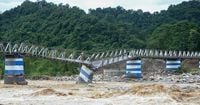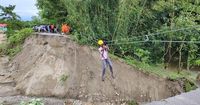Rescue teams in India's northeastern hill district of Darjeeling worked tirelessly through Monday, October 6, 2025, searching for survivors and the missing after devastating landslides and floods swept through the region. Triggered by relentless and heavy downpours, the disaster has left at least 24 dead in Darjeeling alone, with more fatalities reported across the broader state of West Bengal and neighboring Nepal. The human toll and destruction have once again put a spotlight on the mounting dangers posed by extreme weather in South Asia.
According to the Associated Press, Indian army personnel and members of the disaster response force were deployed to sift through debris in hopes of finding those feared trapped. The landslides, which began over the weekend, destroyed homes, wiped out infrastructure, and left hundreds of tourists stranded in Darjeeling, a region famed for its tea plantations and panoramic views of the Himalayas. West Bengal's development minister, Udayan Guha, confirmed that search efforts were ongoing, though hampered by damaged roads and continued rainfall.
Television footage aired across Indian news channels showed rescue workers using earth movers to clear massive piles of mud and rock. "Two iron bridges have collapsed, several roads have been damaged and flooded, huge tracts of land have been inundated," West Bengal Chief Minister Mamata Banerjee stated in a post on X (formerly Twitter), as reported by Reuters. She added that the districts of Darjeeling, Kalimpong, Jalpaiguri, and Alipurduar—all home to lush tea estates—were among the hardest hit. The chief minister also urged tourists to remain in place until authorities could ensure their safe evacuation, reflecting the seriousness of the situation and the ongoing risks posed by the weather.
The rainfall, described by H R Biswas, regional weather head in Kolkata, as "extremely heavy," is expected to persist until at least Tuesday, October 7, 2025. The Indian Meteorological Department echoed these warnings, forecasting further downpours that could complicate rescue and relief efforts. In some of the worst-affected villages, rescuers found themselves unable to reach those in need due to washed-out roads and collapsed bridges. A local disaster management official told Reuters that large amounts of debris littered the roads, making it impossible for teams to access many remote areas.
One of the most dramatic infrastructural failures was the collapse of the Dudhia Iron Bridge over the Balason River, a crucial link between Siliguri and the hill town of Mirik. This, coupled with the destruction of another iron bridge, has further isolated affected communities and complicated the logistics of delivering aid and evacuating the stranded. Visuals from Indian news agency ANI, cited by Reuters, depicted houses in Darjeeling villages filled with mud and rocks, a grim testament to the landslides’ destructive force.
"The entire middle part of our village has been wiped out from the landslide... The land here is very fragile and there's no place to stay and all houses are buried. People are living in relief camp," said Bijay, a local resident, in a quote published by Reuters. His words capture not only the immediate devastation but also the longer-term challenges facing survivors, many of whom have lost their homes and livelihoods.
The tragedy in Darjeeling was mirrored across the border in Nepal, where at least 50 people were killed by landslides and floods, according to the Armed Police Force. The eastern district of Ilam, which borders India, suffered the greatest loss, with 37 deaths reported after entire villages were swept away. The weekend’s heavy rainfall struck just as Nepal’s monsoon season was winding down—a period that typically runs from June to mid-September. The deluge left parts of Kathmandu, Nepal’s capital, under water and forced the cancellation of all domestic flights on Saturday, October 4, 2025.
Rescue operations in Nepal have been equally fraught. District official Bholanath Guragain told Reuters that teams were digging through mud and debris, searching for survivors and clearing blocked roads. The scale of destruction across both countries has left authorities warning that the death toll could rise further as reports trickle in from remote and inaccessible areas.
Darjeeling’s disaster is part of a broader pattern of extreme weather events that have battered South Asia in recent months. In August 2025, a flash flood swept away an entire village in the northern Indian state of Uttarakhand, underscoring the region’s vulnerability to sudden, catastrophic rainfall. According to the Associated Press, cloudbursts, floods, and landslides have caused significant loss of life and property across India, Pakistan, Bangladesh, Bhutan, Sri Lanka, Afghanistan, Maldives, and Nepal this year.
Experts widely attribute the increasing frequency and severity of these events to human-caused climate change. The monsoon, once a relatively predictable phenomenon in South Asia, has become erratic. Instead of steady, moderate rains, the region now experiences sudden bursts of extreme precipitation, followed by unexpected dry spells. This unpredictability not only raises the risk of disasters like the one in Darjeeling but also complicates planning for agriculture, water resources, and disaster management.
As for the immediate aftermath, authorities in West Bengal and Nepal have launched relief and restoration efforts, though the challenges are immense. Hundreds of tourists remain stranded in Darjeeling, their return delayed by impassable roads and ongoing safety concerns. Local officials have set up relief camps for those displaced, but the needs—shelter, food, medical care—are overwhelming.
Meanwhile, in Tibet, Chinese state media reported that rescuers were helping hundreds of hikers trapped by heavy snow at tourist campsites on a slope of Mount Everest. About 350 hikers had reached a meeting point in Tingri County by late Sunday, October 5, 2025, with another 200 still in contact with rescue teams. While not directly related to the South Asian floods, this incident highlights the broader impact of extreme weather across the Himalayan region.
The destruction in Darjeeling and Nepal is a sobering reminder of the growing risks posed by climate change and the urgent need for resilient infrastructure and effective disaster response systems. As the rains continue, the full extent of the tragedy is still unfolding, leaving communities grappling with loss and uncertainty—and prompting calls for greater preparedness in the face of an increasingly volatile climate.


